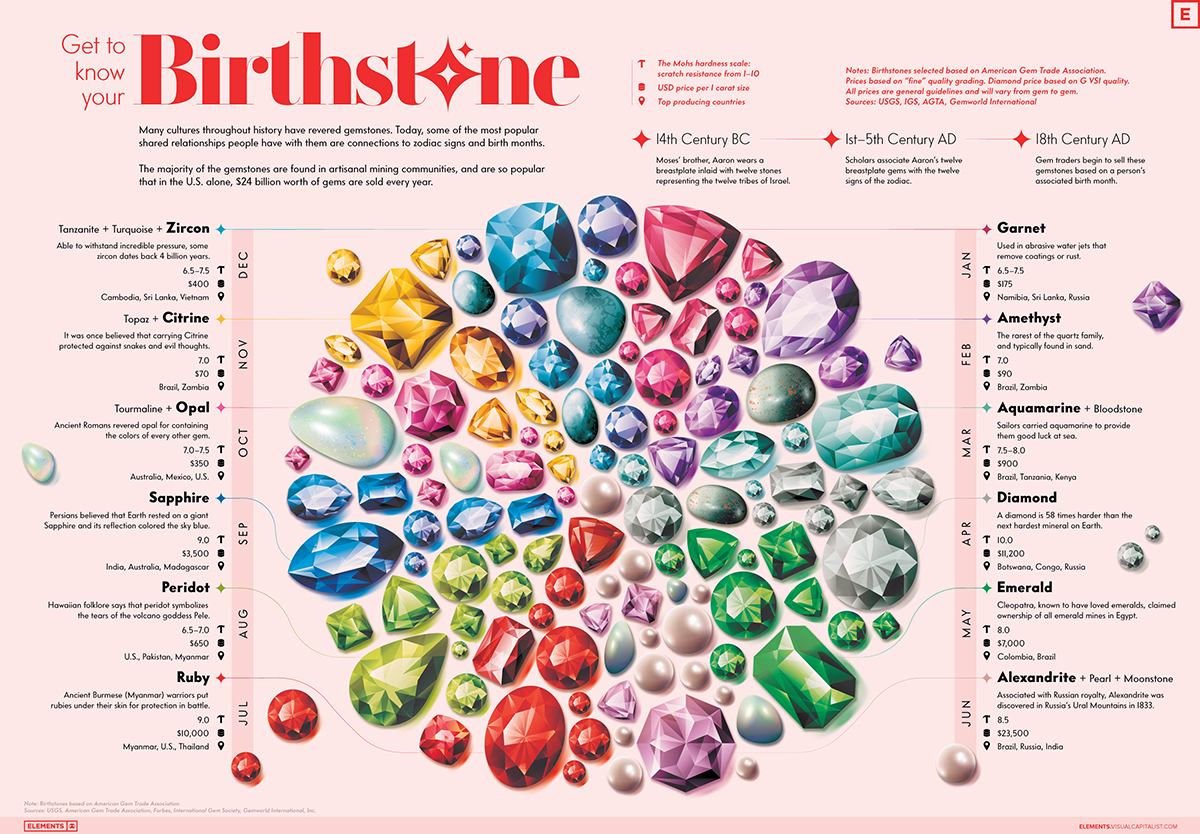What are birthstones?
View the full resolution version of this graphic.

What Are Birthstones?
Many cultures throughout history have revered gemstones.
Gemstones are minerals, rocks, or organic matter that have been chosen for their beauty, durability, and rarity, and then cut or faceted, and polished to make jewelry or other human adornments. There are over 300 gemstones currently documented.
A birthstone is a gemstone that represents a person’s period of birth—usually corresponding to the month or zodiac sign.
In this graphic based on data from the American Gem Trade Association, we look deep into 12 popular birthstones.
What do Birthstones Mean?
Different ancient cultures revered gemstones and connected them to their calendar systems, so there are different lists of birthstones and months that can have more than one gemstone. In Hinduism, for example, there are nine gemstones associated with the Navagraha (celestial forces including the planets, the Sun, and the Moon), known in Sanskrit as Navaratna (nine gems).
Another origin of birthstones traces back to the book of Exodus in the Bible. In Exodus 28, Moses sets forth directions for making special garments for Aaron, the Hebrews’ High Priest and Moses’ elder brother. Specifically, the breastplate was to contain 12 precious gemstones, representing the 12 tribes of Israel.
Given the historical age and numerous translations of the Bible through the ages, there’s been a lot of debate around the identification of the 12 gemstones and no agreement on what the gems actually were.
About 1,500 years after Aaron’s time, in the first centuries of the Christian era, scholars started associating the breastplate gems with the signs of the zodiac. During the 18th century AD, gem traders began to sell gemstones based on a person’s birth month.

In some cultures, it is generally agreed that wearing a gemstone during the month when it is the birthstone heightens its healing powers.
The Birthstones Market
The majority of colored gemstones are extracted by artisanal mining communities around the world, in a very decentralized market.
Gemstone prices can vary from $68 per carat for citrine (November) up to $23,500 per carat for Alexandrite (June). The United States is the leading global market, buying roughly $24 billion in gemstones per year.
Besides different colors and prices, birthstones are also measured according to their hardness. The hardness is evaluated using a scale of 1-10 created by Friedrich Mohs that considers the ability to resist scratching. Diamonds (April) rank 10, being 58 times harder than any other mineral on Earth.
To this day, jewelers continue to add options to birthstone lists. Citrine and spinel (August), for example, are modern additions. Likewise, Tanzanite (December)—the second fastest-selling colored gemstone after Sapphire (September)—was only discovered in 1967 by herders in Tanzania.
(This article first appeared in the Visual Capitalist Elements)
{{ commodity.name }}
{{ post.title }}
{{ post.date }}

Comments